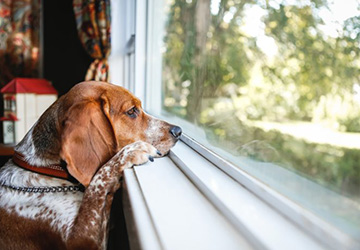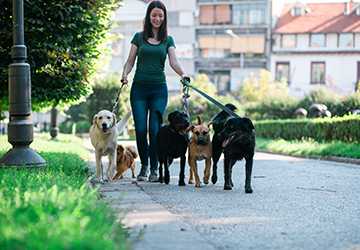Picture this: You're about to leave for work or step out for a quick errand, and suddenly, those pleading eyes and whimpering sounds tug at your heartstrings. Your beloved pet is not ready to bid you farewell, and the struggle with separation anxiety begins. But fear not—finding the right strategies to ease your pet's distress is not a mysterious puzzle. In this guide, we'll embark on a journey to unravel the secrets of handling pet separation anxiety with straightforward, spartan tips that comfort you and your furry companion.

Pets, much like us, don't like sudden changes. If you've noticed your pet getting anxious when you're about to leave, try making your departures less of a big deal. Start by grabbing your keys without making eye contact with your furball; this helps desensitize them to the cues that indicate your departure.
Similarly, when you return, keep things low-key for a few minutes. Avoid lavish greetings until your pet has settled down; this might seem harsh, wildly, when your dog wags its tail excitedly. However, it reinforces that your departures and arrivals are routine, not monumental events.
Imagine if someone plucked you from your familiar surroundings and dropped you in the middle of a bustling, alien world. That's how your pet might feel when you leave them alone. To alleviate this stress, create a cosy, safe space for them to hang out in while you're away.
Choose a room or an area in your home where your pet feels secure. Place their favourite toys, a comfy bed, and maybe an item with your scent (like a worn t-shirt) in this space. This little haven can work wonders in providing comfort and reducing separation anxiety.
Boredom can amplify feelings of loneliness in pets. Keep your furry friend engaged by providing interactive toys and puzzles. These can serve as a distraction and mental stimulation, helping to alleviate anxiety.
Consider toys that dispense treats when played with or puzzles that challenge your pet's problem-solving skills. Not only does this make their alone time more enjoyable, but it also channels their energy into something constructive. Just be sure to rotate the toys occasionally to keep things interesting.
Pets thrive on routine. Knowing what to expect helps them feel secure and reduces anxiety. Establish a consistent daily routine for feeding, walks, playtime, and alone time. This predictability can be incredibly reassuring for your pet.
Stick to a schedule as much as possible, even on weekends. If your pet knows you'll be back home at a particular time each day, it can ease their anxiety about being alone. Consistency is critical, and by incorporating a routine into your pet's life, you provide them with a sense of stability.
It might sound surprising, but the power of music extends beyond human ears—it can soothe your pet's soul, too. When you're away, consider creating a tranquil ambience with calming music or white noise. Numerous specially curated playlists and apps are designed to reduce stress in our furry companions. The gentle melodies or subtle background noise can transform your home into a haven of tranquillity, helping your pet feel more at ease during your absence.
To enhance this experience, experiment with different genres to discover what resonates most with your pet. Some animals respond well to classical compositions, while others find comfort in nature sounds or ambient noise. Tailor the auditory environment to suit your pet's preferences, turning their alone time into a peaceful retreat.
Introducing a change in routine or the presence of a caring human companion can work wonders in alleviating separation anxiety. If your schedule permits, consider enlisting the help of a doggy daycare facility or a trusted pet sitter. These services offer more than just supervision—they provide your pet with vital companionship and stimulation, breaking the monotony of solitude.

In these social settings, your pet can interact with other furry friends or enjoy one-on-one attention from a compassionate human. The dynamic environment helps distract them from your absence and fosters positive social experiences. A well-chosen pet sitter can become a trusted friend, offering the reassurance and engagement your pet craves when you're away.
Harness the power of positivity to reshape your pet's perspective on being alone. Whenever your furry friend displays calm behaviour during departures or greets you with composure upon your return, shower them with praise, treats, or a beloved toy. This strategic use of positive reinforcement creates associations between your arrivals, departures, and positive experiences, dismantling the notion that solitude is a negative ordeal.
Over time, your pet will start to link your comings and goings with joy and rewards, effectively diminishing their separation anxiety. Be consistent with your positive reinforcement efforts, and watch as your pet's anxiety transforms into anticipation, making the time apart more manageable for both of you.
If your pet's separation anxiety persists or appears severe, don't hesitate to consult with your veterinarian. These professionals can thoroughly examine your pet to rule out any underlying health issues contributing to its behaviour. With their expertise, they can offer tailored advice and may recommend professional trainers specializing in separation anxiety.
Medication might sometimes be suggested, particularly in severe cases where additional support is necessary. Your veterinarian can guide you through the options, ensuring your pet receives the appropriate care and interventions to help them cope with their anxiety. Remember, seeking veterinary advice is a proactive step toward enhancing your pet's overall well-being and happiness.
As we wrap up this guide, remember that overcoming pet separation anxiety is a journey, not a sprint. By incorporating these spartan yet adequate tips into your routine, you're laying the foundation for a calmer tomorrow—one where your pet can confidently embrace moments of solitude. With gradual goodbyes, comforting havens, stimulating distractions, and professional guidance if needed, you're well-equipped to transform separation anxiety into a distant memory. So, stay patient and consistent, and savour the joy of a happier, more relaxed pet—and a more worry-free you.